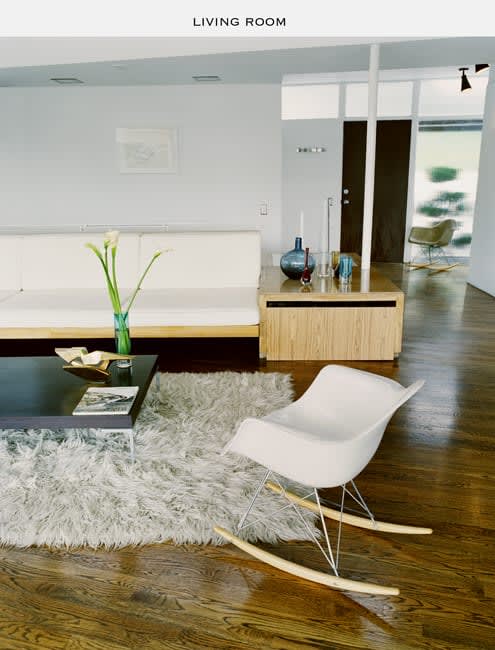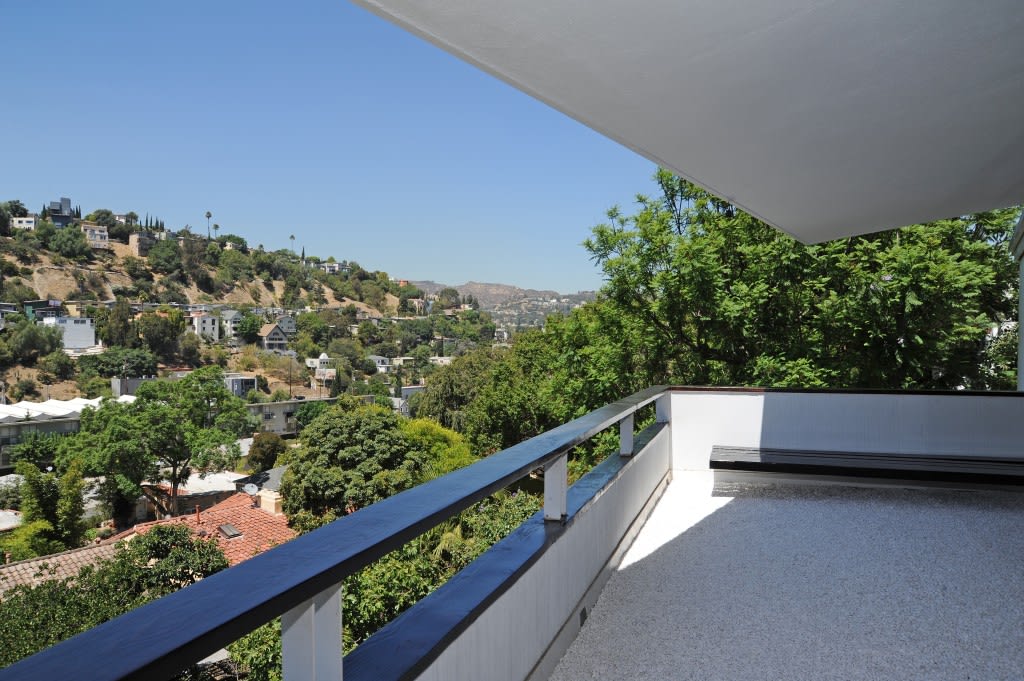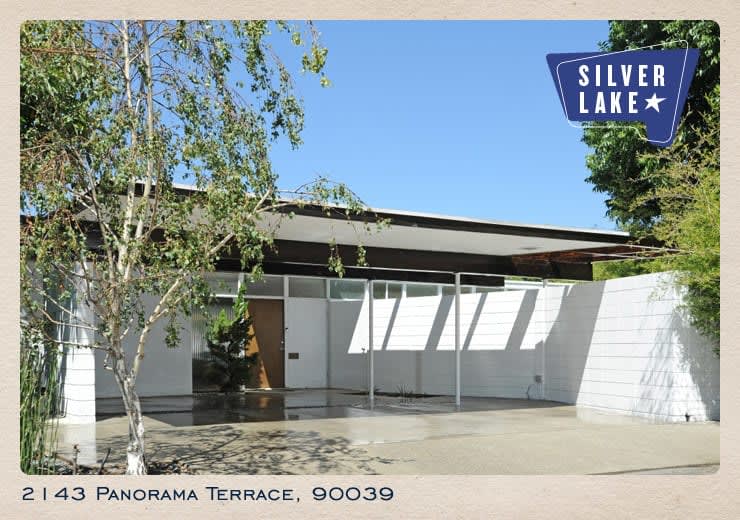2143 Panorama Terrace is a stunning mid-century modern home designed and built in 1953 by acclaimed architect James H. Garrott for accalimed artist, Bernice "Burr" Singer (1912-1992).
| 3 BEDS & 2 BATHS | LP $1,137,000 | BUILT 1953 | 1,999 SQ. FT. |
|---|
The Neighborhood of Silver Lake, in Los Angeles, recognized by Forbe’s Magazine as home to some of the most avant garde Modernist architecture in North America, offered one of its iconic homes on the market. 2143 Panorama Terrace is a stunning mid-century modern home designed and built in 1953 by acclaimed architect James H. Garrott for accalimed artist, Bernice “Burr” Singer (1912-1992). The artist’s retreat features over 1,900 sq. ft. of living space with 3 bedrooms and an inspiring art studio.

Entry into the house is downward, following the slope of the hillside, into the protection of the main living area. From there, floor to ceiling glass walls face west, toward Franklin Hills and beyond.

Custom-built couches floating above hardwood floors evoke a bearable lightness of being.

A balance of natural wood and unconstrained lines orchestrate the Dramatic open floor plan.

The roofline extends outward, providing a covered refuge on the shaded patio. The expansive canyon views are inspiring.

Clearstory windows over the Eastern entry carry natural light to the inner space.

Original shelving behind the couch flank the staircase to lower living quarters. The art studio, in the upper right background, is swathed in diffused natural light.

Open kitchen dining space with original cabinetry. One feels as if there are no boundaries. The dining room invites the visitor to a casual affair.

Yes, that’s an original Western-Holly stove & range top, intact, and functional. Manufactured in Culver City, Western-Holly stoves are recognized by a signature round window like a porthole of a ship, and an innovative removable rack system that allowed for additional cooking space.

Well placed recessed lighting over work stations.

Abundant storage and extended counter space created a cook’s kitchen to last well into the next millennium. Note the streamline drawers and cabinets with cuts in the wood for hand-grabs sans decorative handles.

The oversized balcony spans the entire main floor. The quintessential indoor/outdoor experience reflects the simplicity and elegance that Southern California mid-century modern architects consistently implemented into their designs. Well-placed Bose cube speakers connect the home through sound: the perfect setting for relaxation or entertaining.

The master bedroom is also located on the main floor with direct secluded access to the pool.

Floating cabinetry and clearstory windows in the master bathroom maximize natural light without compromising privacy.

Downstairs are two bedrooms and an office all with large windows maintaining a strong connection between the indoors and outdoors.

The 2nd Bedroom has a wall of brick the use of material detail that softens the starkness often associated with modern design.

The lower level bathroom incorporates the same 1″ white tile as the upstairs master bathroom offering a clean and simple aesthetic.
2143 Panorama Terrace – Heart

The art studio was originally built for the 1st Owner who was an accomplished and celebrated painter and sculptor, “Burr” Singer (1912-1992). Bernice Lee Singer was a native of St. Louis and studied at that city’s School of Fine Arts, as well as at the Art Institute of Chicago, the Art Students League in New York City, and in Taos, New Mexico, in private classes with Walter Ufer. A portraitist and lithographer, she began exhibiting in the late 1930s and early ’40s. Her works were included in an exhibition of prints at the Library of Congress in 1983.

Essential artist’s utility and flat archival storage were custom-designed by Architect James H. Garrott for the original owner and painter, Burr Singer.

With a connection to her living space and inspiration, Burr Singer worked on many of her famous paintings here. Her watercolors often depicted local people whom she felt had depth and character.

Doorway, Singer was concerned with the plight of workers, the lower classes and minorities. She frequently depicted scenes of laborers, African Americans, and others, working, riding on buses, and in other Social Realist scenes.


“Dock Workers” c. 1940

More views encouraging creativity: this is from the balcony looking North. That’s the Griffith Observatory and surrounding parkland in the distance.

Only invited visitors know of this place. A private outdoor living space strategically hidden from the street. The pool is surrounded by towering bamboo and precision block walls. It’s completely camouflaged from the surrounding homes with access points only through the carport or the master bedroom. Very cool.

In 2003, according to public records, the home was sold to photographer Pascal Demeester for $900,000, whose work consists mostly of fashion and beauty shots. In 2006, Demeester began creating an unlimited series of conceptual surrealistic images. These Images included some fashion ingredients intermixed with the surrealistic association of objects, individuals, words and landscapes, removing their utilitarian purpose so as to be perceived as a field in which the viewers would be able to liberate their thoughts and let their spirit create a mental association as desired. From 2001 to 2010, Demeester divided his time between New York and Los Angeles working as a Fashion Photographer spending most of his time in Los Angeles incorporating California’s exceptional landscapes into his photography.

Demeester contributed a number of his own photos and perspectives on the house for the listing. The property was on the market for a short seven days. Over 250 people viewed the house, which garnered multiple offers and sold above the list price in 2010. Demeester moved to NYC and the proud new owners modernized the home to suit their lifestyle.
History: Architect James H. Garrott built the home for Bernice (Burr) Singer in 1953
Garrott was based in the Silver Lake neighborhood of Los Angeles.
Silver Lake is characterized by hilly terrain, narrow streets, beautiful vistas and a large number of homes designed by a veritable who’s who of mid-century design, such as Richard Neutra (1892-1970), Gregory Ain (1908 – 1988), John Lautner (1911-1994), R.M. Schindler (1887-1953) and Frank Lloyd Wright Jr. (1890 – 1978; aka Lloyd Wright). From Silver Lake one can spy the Hollywood Sign, Griffith Park Observatory and even the Pacific Ocean some 17 miles away.

James Homer Garrott (June 19, 1897, Montgomery, Alabama – June 9, 1991) was an African-American architect active in the Los Angeles area in the mid-20th century. He designed more than 200 buildings, including twenty-five churches and several public buildings. He has been described as a “pivotal black avant garde modernist of the 1940s era.”
Garrott graduated from Los Angeles Polytechnic High School in 1917. He earned his architect’s license in 1928. He then studied Architecture at the University of Southern California from 1930 to 1934. In 1946, Garrott was the second African-American admitted to the American Institute of Architects (AIA) in Los Angeles, after Paul R. Williams. His application was sponsored by Williams and Gregory Ain.
Garrott and Ain shared office space and worked together in a “loose partnership” in the 1940s and 50s, and together designed a small office building that they shared in the Silver Lake neighborhood of Los Angeles. They were alternately “Garrott & Ain” or “Ain & Garrott,” depending on who was responsible for design, while on other projects they simply assisted each other’s solo work without credit.
Politically well-connected, Garrott received nine commissions from the Los Angeles County Government in the late 1950s.He was politically active as a member of the NAACP, the URBAN League, and as a member of an informal group of progressiviely-minded designers that included Richard Neuatra, Garrect Eckbo and Julius Shulman.




